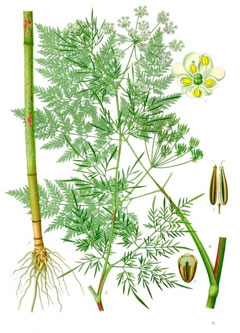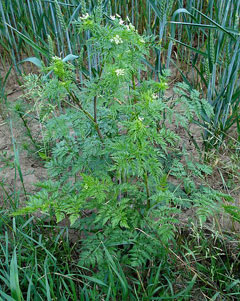 |
|
http://commons.wikimedia.org/wiki/File:Koeh-177.jpg |
 |
| http://commons.wikimedia.org/wiki/User:Fornax |
Translate this page:
Summary
Physical Characteristics

 Chaerophyllum bulbosum is a BIENNIAL growing to 1.2 m (4ft).
Chaerophyllum bulbosum is a BIENNIAL growing to 1.2 m (4ft).
See above for USDA hardiness. It is hardy to UK zone 6. The species is hermaphrodite (has both male and female organs) and is pollinated by Insects. The plant is self-fertile.
Suitable for: light (sandy), medium (loamy) and heavy (clay) soils. Suitable pH: mildly acid, neutral and basic (mildly alkaline) soils. It can grow in semi-shade (light woodland) or no shade. It prefers moist soil.
UK Hardiness Map
US Hardiness Map
Synonyms
Plant Habitats
Meadow; Cultivated Beds;
Edible Uses
Edible Parts: Root Stem
Edible Uses:
Root - raw or cooked[2, 33, 34, 37, K]. The raw root is rather tough, but has a nice, aromatic, starchy flavour[K]. When cooked it becomes floury and sweet[27] with a peculiar flavour that is excellent and unlike any other vegetable[183]. Peeling the roots ruins the flavour[183]. The root is about the size of a small carrot[2]. It can be harvested when the foliage dies down, usually in July/August from an autumn sowing, and stored like potatoes for later use[1]. It is best harvested as required[164]. The roots contain about 20% starch and 4% protein[74]. Young stems - raw or cooked[74]. Some caution is advised, see notes at the top of the sheet.
References More on Edible Uses
Medicinal Uses
Plants For A Future can not take any responsibility for any adverse effects from the use of plants. Always seek advice from a professional before using a plant medicinally.
None known
References More on Medicinal Uses
The Bookshop: Edible Plant Books
Our Latest books on Perennial Plants For Food Forests and Permaculture Gardens in paperback or digital formats.

Edible Tropical Plants
Food Forest Plants for Hotter Conditions: 250+ Plants For Tropical Food Forests & Permaculture Gardens.
More

Edible Temperate Plants
Plants for Your Food Forest: 500 Plants for Temperate Food Forests & Permaculture Gardens.
More

More Books
PFAF have eight books available in paperback and digital formats. Browse the shop for more information.
Shop Now
Other Uses
References More on Other Uses
Cultivation details
An easily grown plant, succeeding in almost any soil[1], though it prefers a moist soil[27]. Tolerates a pH in the range 4.6 to 7. The turnip-rooted chervil is occasionally cultivated for its edible root[46, 61], there is at least one named variety[183]. The sub-species C. bulbosum prescottii (synonym C. prescottii) is used in Russia[74]. The root of this sub-species contains about 17% starch[74].
References Carbon Farming Information and Carbon Sequestration Information
Temperature Converter
Type a value in the Celsius field to convert the value to Fahrenheit:
Fahrenheit:
The PFAF Bookshop
Plants For A Future have a number of books available in paperback and digital form. Book titles include Edible Plants, Edible Perennials, Edible Trees,Edible Shrubs, Woodland Gardening, and Temperate Food Forest Plants. Our new book is Food Forest Plants For Hotter Conditions (Tropical and Sub-Tropical).
Shop Now
Plant Propagation
Seed - best sown in the autumn in situ[33]. The seed has a very short viability[1] or, according to another report, the seed becomes dormant if allowed to dry out and will not germinate for a year[164]. If stored for a spring sowing it should be kept in damp sand in a cold but frost-free place and then sown in situ in March[1]. Another alternative is to sow the seed in the autumn in a seed tray in a cold frame and then to sow the seed, soil and all, in early April in situ[164].
Other Names
If available other names are mentioned here
Native Range
TEMPERATE ASIA: Iran (north), Turkey (north), Russian Federation-Ciscaucasia (Ciscaucasia), Armenia, Azerbaijan, Georgia EUROPE: Finland, Sweden, Austria, Switzerland, Czech Republic, Germany, Poland, Slovakia, Russian Federation (European part), Belarus, Estonia, Lithuania, Latvia, Moldova, Ukraine (incl. Krym), Bulgaria, Bosnia and Herzegovina, Croatia, Italy (north), North Macedonia, Montenegro, Romania, Serbia, Slovenia, France
Weed Potential
Right plant wrong place. We are currently updating this section.
Please note that a plant may be invasive in one area but may not in your area so it's worth checking.
Conservation Status
IUCN Red List of Threatened Plants Status :

Growth: S = slow M = medium F = fast. Soil: L = light (sandy) M = medium H = heavy (clay). pH: A = acid N = neutral B = basic (alkaline). Shade: F = full shade S = semi-shade N = no shade. Moisture: D = dry M = Moist We = wet Wa = water.
Now available:
Food Forest Plants for Mediterranean Conditions
350+ Perennial Plants For Mediterranean and Drier Food Forests and Permaculture Gardens.
[Paperback and eBook]
This is the third in Plants For A Future's series of plant guides for food forests tailored to
specific climate zones. Following volumes on temperate and tropical ecosystems, this book focuses
on species suited to Mediterranean conditions—regions with hot, dry summers and cool, wet winters,
often facing the added challenge of climate change.
Read More
Expert comment
Author
L.
Botanical References
93200
Links / References
For a list of references used on this page please go here
Readers comment